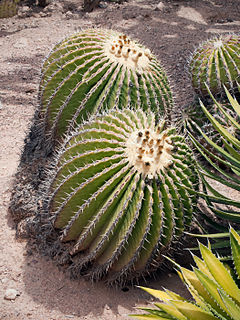
Clematis is a genus of about 300 species within the buttercup family, Ranunculaceae. Their garden hybrids have been popular among gardeners, beginning with Clematis × jackmanii, a garden standby since 1862; more hybrid cultivars are being produced constantly. They are mainly of Chinese and Japanese origin. Most species are known as clematis in English, while some are also known as traveller's joy, a name invented for the sole British native, C. vitalba, by the herbalist John Gerard; virgin's bower for C. terniflora, C. virginiana, and C. viticella; old man's beard, applied to several with prominent seedheads; leather flower for those with fleshy petals; or vase vine for the North American Clematis viorna.

Echinocactus grusonii or Kroenleinia grusonii, popularly known as the golden barrel cactus, golden ball or mother-in-law's cushion, is a species of barrel cactus which is endemic to east-central Mexico.

Phyla nodiflora, the frog fruit, sawtooth fogfruit, or turkey tangle, is an ornamental plant in the family Verbenaceae, and is native to the area from northern South America to southern United States. It can be found in tropical areas around the globe, a naturalized species in many places. This plant is cited in Flora Brasiliensis by Carl Friedrich Philipp von Martius.
This article is a list of biological species, subspecies, and evolutionary significant units that are known to have become extinct during the Holocene, the current geologic epoch, ordered by their known or approximate date of disappearance from oldest to most recent.
The central Texas pocket gopher or Llano pocket gopher is a species of rodent in the family Geomyidae. It is endemic to central Texas in the United States.
Mastigodiaptomus is a genus of Neotropical copepods in the family Diaptomidae. Two of the eight species in the genus are listed as Data Deficient (DD) on the IUCN Red List, and one is listed as a vulnerable species (VU):
Bat Conservation International (BCI) is an international nongovernmental organization working to conserve bats and their habitats through conservation, education, and research efforts.
Tersomius is an extinct genus of dissorophoid temnospondyl within the family Micropholidae. It is known from the early Permian of North America.

Echinocactus platyacanthus, also known as the giant barrel cactus, golden barrel cactus, giant viznaga, or biznaga de dulce, is a species of cactus. It is native to central Mexico in the Chihuahuan Desert. This species is the largest of the barrel cacti. In Mexico the hairs are often used for weaving; a traditional candy is produced by boiling the pith.

The World's 25 Most Endangered Primates is a list of highly endangered primate species selected and published by the International Union for Conservation of Nature (IUCN) Species Survival Commission (SSC) Primate Specialist Group (PSG), the International Primatological Society (IPS), Global Wildlife Conservation (GWC), and Bristol Zoological Society (BZS). The IUCN/SSC PSG worked with Conservation International (CI) to start the list in 2000, but in 2002, during the 19th Congress of the International Primatological Society, primatologists reviewed and debated the list, resulting in the 2002–2004 revision and the endorsement of the IPS. The publication was a joint project between the three conservation organizations until the 2012–2014 list when BZS was added as a publisher. The 2018–2020 list was the first time Conservation International was not among the publishers, replaced instead by GWC. The list has been revised every two years following the biannual Congress of the IPS. Starting with the 2004–2006 report, the title changed to "Primates in Peril: The World's 25 Most Endangered Primates". That same year, the list began to provide information about each species, including their conservation status and the threats they face in the wild. The species text is written in collaboration with experts from the field, with 60 people contributing to the 2006–2008 report and 85 people contributing to the 2008–2010 report. The 2004–2006 and 2006–2008 reports were published in the IUCN/SSC PSG journal Primate Conservation,, since then they have been published as independent publications.

Echinocactus horizonthalonius is a species of cactus known by several common names, including devilshead, turk's head cactus, blue barrel cactus, eagle's claw, horse maimer, horse crippler, and visnaga meloncillo. It is native to the southwestern United States and northern Mexico, where it occurs in Chihuahuan Desert and Sonoran Desert habitats, particularly on limestone substrates. One of its varieties is a federally listed endangered species of the United States.

Parodia herteri is a species of cactus in the subfamily Cactoideae. It is endemic to Brazil. It was named for botanist Wilhelm Herter. The first description was in 1936 as Echinocactus herteri by Erich Werdermann. It was described as Parodia herteri in 1987 by Nigel Paul Taylor.

Echinocactus parryi is a cactus in the subfamily Cactoideae. It is endemic to the Mexican state of Chihuahua. It has one synonym. E. parryi is thought to be quite similar to E. polycephalus but they differ in their branching habits, average number of ribs per stem, flower color and more. Echnocactus parryi is known to produce an average of 13 ribs per stem, pubescent spines and yellow flowers with a little red in the middle.
Devil's pincushion is a common name for several cacti and may refer to:









